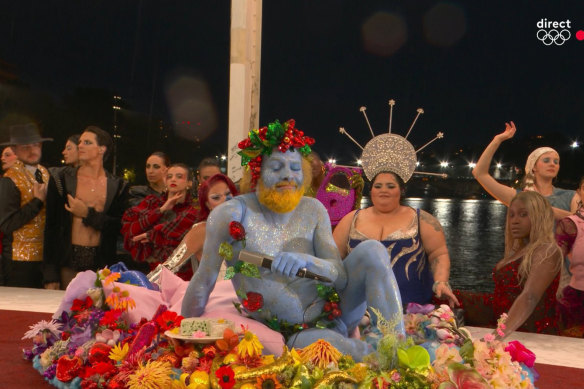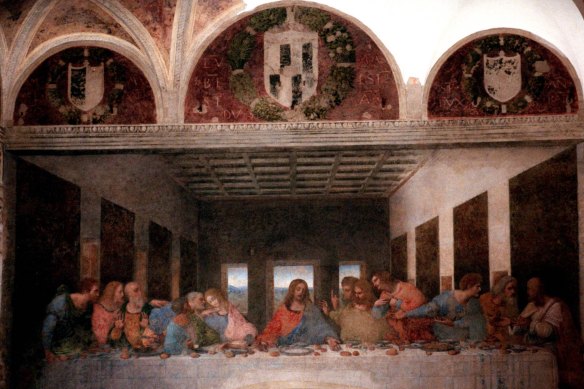This was published 8 months ago
‘Gross mockery’: Did Paris’ blue man really parody Last Supper?
A performance during the Paris Olympics’ opening ceremony Friday has drawn criticism from church leaders and conservative politicians for a perceived likeness to Leonardo da Vinci’s depiction of a biblical scene in “The Last Supper,” with some calling it a “mockery” of Christianity.
The event’s planners and organisers have denied that the sequence was intended to mock or offend, and have remained largely vague about the references associated with the images.

‘Message of love and inclusion’: the interpretation of the Greek God Dionysus.Credit: Twitter
In the performance broadcast during the ceremony, a woman wearing a silver, halo-like headdress stood at the centre of a long table, with drag queens posing on either side of her. Later, at the same table, a giant cloche lifted, revealing a man, nearly naked and painted blue, on a dinner plate surrounded by fruit. He broke into a song as, behind him, the drag queens danced.
The tableaux drew condemnation among people who saw the images as a parody of “The Last Supper,” the New Testament scene depicted in da Vinci’s painting by the same name. The French Bishops’ Conference, which represents the country’s Catholic bishops, said in a statement that the opening ceremony included “scenes of mockery and derision of Christianity,” and an influential American Catholic, Bishop Robert Barron of Minnesota, called it a “gross mockery.”
The performance at the opening ceremony, which took place on and along the Seine on Friday, also prompted a Mississippi-based telecommunications provider, C Spire, to announce that it would pull its advertisements from Olympics broadcasts. House Speaker Mike Johnson described the scene as “shocking and insulting to Christian people.”
The opening ceremony’s artistic director, Thomas Jolly, said at the Games’ daily news conference Saturday that the event was not meant to “be subversive, or shock people, or mock people.” Speaking broadly about the ceremony, he said, “The idea was to send a message of love and of inclusion.” On Sunday, Anne Descamps, the Paris 2024 spokesperson, said at the daily news conference, “If people have taken any offence, we are, of course, really, really sorry.”
It is unclear whether the drag queens scene was intended to reference “The Last Supper.” The official account of the Olympic Games said on the social media platform X that the scene with the blue-painted man, French actor and singer Philippe Katerine, was an interpretation of Dionysus, the Greek god of wine and revelry, which “makes us aware of the absurdity of violence between human beings.”
For some, though, the resemblance to da Vinci’s painting was undeniable.
“The idea of the central figure with a halo and a group of followers on either side — it’s so typical of ‘The Last Supper’ iconography that to read it in any other way might be a little foolhardy,” said Sasha Grishin, an art historian and professor emeritus at the Australian National University.
The central figure wearing the headdress was reminiscent of High Renaissance-style Last Supper paintings, in which Jesus is depicted with a halo or light around his head, Grishin said. In some paintings, this is portrayed as a gold circle. In others, like da Vinci’s, Jesus is backlit by a window or has a subtle radiance around him.
The drag queens’ poses also resembled those of Jesus’ disciples, he said, adding that the scene was a “very, very sacred image” to Christians as it represented the moment that Jesus announced he was prepared to sacrifice himself for humanity’s sins.
Others, however, argued that it was not immediately clear that the scene was referencing “The Last Supper.”
For one, there were at least 17 drag queens — and more during Katerine’s song — versus Jesus’ Twelve Apostles, said Louise Marshall, an honorary senior lecturer at the University of Sydney and an expert in Renaissance art. “That’s basic. You kind of have to have that number.”

Leonardo Da Vinci’s ‘The Last Supper’.Credit: Leonardo da Vinci
To reference the Last Supper — particularly the da Vinci version, although many paintings have featured the scene — the apostles are usually clustered in three groups of four, connected visually through gestures that they make toward one another, Marshall said. The drag queens’ poses, she said, seemed more like vogueing, a style of dance closely linked to drag culture. The table should also be set up for a meal with food across the table, rather than the pile of fruit the blue-painted man was sitting on, she said.
“Frankly, when I looked at the clips, ‘The Last Supper’ isn’t necessarily what springs to mind,” she said. “It seems very lighthearted and funny and witty and very inclusive.”
“The Last Supper” has been frequently referred to in pop culture over the years. In an episode of “The Simpsons” called “Thank God It’s Doomsday,” Homer and his friends re-create the tableau in a bar, and the shows “The Sopranos,” “Lost” and “Battlestar Galactica” have all used the scene in promotional images.
This article originally appeared in The New York Times.